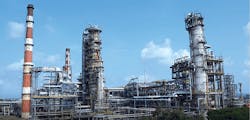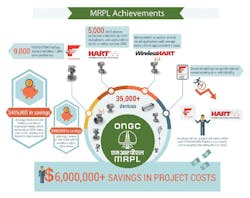Source: MRPL
Brave poker players go “all in” to show their confidence in their cards. Equally bold process engineers demonstrate similar commitment when they implement steadily increasing ratios of advanced digital communication protocols like HART, WirelessHART and FOUNDATION Fieldbus. However, only an elite few go on to claim the FieldComm Group’s annual Plant of the Year Award, and earn the much-deserved recognition that goes with being a leading adopter of FieldComm protocols and technologies.This year’s winner, Mangalore Refinery and Petrochemicals Ltd. (MRPL), exhibits all these qualities, but it’s also noteworthy because it’s the first recipient from India, and represents the nation’s burgeoning oil, gas and petrochemical sector that’s been rapidly securing a preeminent place on the worldwide stage. MRPL’s staff reports its “do things better” culture inspires it to be a pioneer and frontrunner in hydrocarbon processing, adopt digital communications for process control, and continuously strive for more effective utilization of its resources and facilities. MRPL jumps wholeheartedly into everything it does, including implementing FieldComm Group solutions.
Established in 1995, MRPL is a 15 million tonnes per annum (MMTPA) oil and gas refinery located on 1,550 acres in Mangalore, Karnataka state, on the west coast of India. It’s part of India’s state-owned Oil and Natural Gas Corp. (ONGC), a Navaratna Nine Precious Gems) company, and its full range of products include liquid petroleum gas, Motor Spirit (gasoline), High Speed diesel gas and oil, kerosene, aviation turbine fuel, naphtha, coke, polypropylene, fuel oil, bitumen, sulfur and others. It also supplies raw materials such as naphtha and mixed xylenes to ONCG Mangalore Petrochemicals Ltd. (OMPL), which is a 0.9-MMTPA joint-venture petrochemical facility by ONGC and MRPL that started operations in 2014. OMPL is completely built on digital technology including FOUNDATION Fieldbus for process
Striding into fieldbus
MRPL started its journey into FieldComm Group technologies in 2005, when it installed all-digital communications on its isomerization unit. This project included implementing all process control loops with FOUNDATION Fieldbus with control in the field (CIF) functions, as well as HART transmitters used in its safety instrumented systems (SIS). On the strength of this success, MRPL raised the stakes in 2012 by also commissioning more than 10 process units, cogeneration plant and utilities at its 3-MMTPA refinery with FOUNDATION Fieldbus, HART and WirelessHART. They’re also MRPL’s default process control protocols for future upgrades and added capacity projects.
“We had experience with digital protocols such as DE, Brain and HART since MRPL’s inception in 1995, and also used TRL/2 bus for tank gauging since then,” says Basavarajappa Sudarshan, chief general manager for electrical and instrumentation at MRPL and project team leader. “We learned about FOUNDATION Fieldbus on the Internet and from suppliers. Its advantages included less cabling needed and a smaller footprint in the plant’s Yokogawa DCS in terms of I/O, panels and rack space required.
“This led us to seek acceptance from MRPL management for an upgrade including interoperability of field devices. We visited with major DCS suppliers, and did many interoperability tests during four to six weeks in 2004 to resolve concerns and anxiety about such a new installation. This is how we introduced FOUNDATION Fieldbus in our new isomerization plant in 2005, which made MRPL the first company in India to construct a hydrocarbon process unit using entirely FOUNDATION Fieldbus for closed-loop process control.”
Convincing workers
Beyond determining the technical advantages of FOUNDATION Fieldbus and other FieldComm Group technologies, Sudarshan reports that he and his team had to convince colleagues, including operators and managers at MRPL, that migrating to digital communications would be worthwhile and wouldn’t hinder operations.
Other core team members included: Suryanarayana, chief project manager; Ganesh Bhat, chief instrumentation manager; Allen John, senior instrumentation manager; Muralidhara Karanth, instrumentation manager, and Deepthi K.M., assistant instrumentation manager, who added to the discussion about MRPL’s successful use of FieldComm Group technologies.
“We ensured participation of everyone concerned like C&I, projects and process operations in discussions and technical presentations,” explains Sudarshan. “In 2005, technicians with experience with conventional DCS and field devices took some time to understand the new digital technology. However, with guidance from our field device and other suppliers, they were trained on the job, and quickly streamlined use of FOUNDATION Fieldbus, which was initiated during pre-commissioning. The team had no issues in adopting the technology.”
Sudarshan also credits MRPL management with giving his team and other staffers the crucial support they needed to evaluate, design, test and implement HART, WirelessHART and FOUNDATION Fieldbus into their process applications. “Management gave us a lot of freedom, which enabled our excellent people on the forefront of these projects to be open to FOUNDATION Fieldbus,” says Sudarshan. “Many were skeptical about these digital technologies, so they were first teased and tried on non-critical, open loops before being used on closed loops. Once users and managers got more confident, we were able to take everything forward.”
Big moves = Big rewards
Consequently, MRPL reports that adopting FieldComm Group and other digital technologies on entire process units allowed its installed equipment to achieve versatility and performance gains faster than if it had implemented them in small increments. So far, the refinery has tested and installed digital devices and functions for almost all of its various applications, from simple DP measurement to complex analyzers and nucleonic level measurement. At present, digital device deployments at MRPL include:
• More than 3,000 FOUNDATION fieldbus segments using several concepts, including FISCO, FNICO, FISCO ic and HPT. Many applicable FOUNDATION Fieldbus interfaces, diagnostics components and junction boxes were supplied by Pepperl+Fuchs, which also furnishes temperature multiplexers.
• More than 35,000 total devices, including more than 9,000 FOUNDATION Fieldbus and 5,000 HART components.
• Developing its CIF potential, more than 75% of valve positioners at MRPL employ FOUNDATION Fieldbus. These include 1,500 with FOUNDATION Fieldbus and 450 with HART. Primary positioner suppliers are Metso and Emerson.
• Nearly 70% of the refinery’s more than 10,000 other transmitters for pressure, radar level and Coriolis mass flow use FOUNDATION Fieldbus, while the rest use HART. Emerson, Honeywell, and Yokogawa are the primary suppliers of these devices.
• More than 215 motor-operated valves (MOV) and controls at MRPL’s Phase 3 cogeneration power plant also employ FOUNDATION Fieldbus. They’re supplied by Rotork, and deliver as many as seven parameters each, which reduced I/O, cabling and footprint requirements by 80% and saved $415,000.
Sudarshan reports that FieldComm Group technologies generate savings for MRPL in a variety of ways. “We achieved an average savings of 50% on I/O, cabling and installation costs for new projects,” he says. “There’s an average savings of 15 minutes per month per valve in terms of preventive maintenance, which results in an average savings of 55 man days per month in applications with digital valve positioners. In addition, we get early detection of failures in devices that had no preventive maintenance plans before diagnostic-enabled devices were available. Though these particular benefits can’t be quantified in terms of cost savings, they’ve nonetheless improved refinery uptime. Thanks to all these gains, we’ve saved approximately $6.6 million compared to project costs that take into account added costs of conventional I/O and cabling compared to FOUNDATION Fieldbus.”
Less downtime, more efficiency
Muralidhara Karanth says there have been several other specific instances where FieldComm Group technology has improved operations, prevented downtime, or enabled other gains. These events include:
• Avoided shutting down a sour water stripping unit during a DCS upgrade in 2016 by using FOUNDATION Fieldbus, which allowed MPL to take the DCS controller offline while the unit continued running. Key parameters were monitored through local indicators, controllers were left in normal mode, and the unit ran normally without disturbances until the upgrade was done.
• Using HART pass-through I/O modules in DCS and safety systems delivers the added advantage of mapping critical secondary and tertiary parameters from HART devices to the DCS for better operation and maintenance. Critical inputs from HART devices like control valve position feedback from valve positioners, density from Coriolis mass flowmeters, and cell temperature from pressure transmitters can be mapped to the DCS.
• Wireless DP transmitters are cost-effectively achieving required backup tank level measurements and better process visibility in the shortest possible time by installing HART gateways and signal repeaters in the tank farm. This solution is also used for control valve leak detection via acoustic transmitters, and MRPL has made it mandatory to use WirelessHART in upcoming refinery units for applications like pump seal monitoring, control valve leak detection, etc.
• More intelligent field devices and the Yokogawa PRM asset management system (AMS) have redefined the preventive maintenance techniques and enabled advanced diagnostics. For example, critical control valves are monitored regularly by the AMS, valve signatures are captured during turnarounds and corrective actions are taken. In addition, valve position feedback is integrated to valve control function blocks, which allows better tuning of control loops and diagnostics. FOUNDATION Fieldbus physical layer health is tested regularly with DTM-based diagnostic tools and corrections are performed. Also, MRPL is in the process of making a preventive maintenance template based on the NAMUR NE107 standard.
• Because FCC reactor instrument nozzles in slurry service are prone to choking with catalyst, critical delta pressure transmitters are used for actuating shutdown on low pressure. To better detect plugged impulse lines, Emerson supplied 3051S transmitters with Advanced Diagnostics Suite software. MRPL tested this solution in sample applications, and is in the process of extending them throughout the unit.
• Available valve position feedback indication improved unit operation. In 2017, a failing actuator in a PSA purge gas valve was identified by valve positioner diagnostics, which averted a potential hydrogen unit shutdown. Breakdown of this valve would have brought down MRPL’s diesel hydrotreater unit for 72 hours. Fuel and energy loss for startup and shutdown of the hydrogen unit alone would have cost $60,000.
“Using open standards lets us integrate smart instruments throughout the entire plant, including extensive use of HART in our safety systems that enable capabilities like partial stroke testing, as well as CIF from FOUNDATION Fieldbus that lets us operate even with the loss of critical hardware—giving our team peace of mind,” says Suryanarayana. “In 2016, we were able to keep the refinery process running during that DCS upgrade, which would have resulted in a production loss conservatively estimated at $800,000 without CIF.”
Suryanarayana adds that MRPL benefited greatly from adopting digital technology during its early stage, and achieved considerable savings in commissioning time, improved process visibility, reduced DCS footprint, and simple, effective maintenance practices thanks to better utilization of device diagnostics. “FOUNDATION fieldbus physical layer diagnostic tools have simplified our diagnostic procedures and improved the uptime of the process units,” he explains. “Innovative techniques, like carrying out FOUNDATION Fieldbus loop checking using device display, segment-wise device commissioning, etc., reduced pre-commissioning time and required resources.” Likewise, availability of multiple parameters from single instruments and getting the values to the operators has improved quality of process operations and ease of maintenance.
Ganesh Bhat, who worked for OMPL from its conceptualization stage in 2007 until its construction stage in 2011 on deputation from MRPL, reports that OMPL’s Aromatic complex that produces paraxylene and benzene has also completely adopted FieldComm Group technology. “This greenfield petrochemical (aromatics) complex of OMPL didn’t face any difficulty in plant commissioning with FOUNDATION Fieldbus and HART,” says Bhat. “They use all FOUNDATION Fieldbus and HART features for predictive and preventive maintenance, and these technologies also make their maintenance tasks easier and simpler.”
Sudarshan adds, “Overall, there’s been a paradigm shift in how instrumentation maintenance has been carried out ever since MRPL introduced FOUNDATION Fieldbus into its process units in 2005. For instance, breakdown maintenance calls are converted to predictive maintenance, and preventive maintenance activity has been shifted to the control room from former routine, manpower-intensive field visits. The biggest advantage of smart devices is the self diagnostics of the devices. They’ve been tapped to avert breakdowns due to instrumentation failure, and this increased on-stream availability of the whole refinery.”
Other users catch on
Sudarshan adds that many of India’s other major industrial manufacturers have been observing and joining its digitalization initiative movement in increasing numbers.
“Once it became known that we’d implemented FOUNDATION Fieldbus, HART and WirelessHART, and were reaping considerable benefits, representatives from other Indian refineries approached us, and since then, many of them have started using FieldComm Group technologies, too,” adds Sudarshan. “In fact, anyone who reads our story is welcome to visit MRPL for a detailed discussion on using FieldComm technologies.”

Leaders relevant to this article:





